Analysis of a Grid-Connected Solar PV System with Battery Energy Storage for Irregular Load Profile
Abstract
:1. Introduction
1.1. Literature Review
1.2. Main Contribution
2. Methodology
Evaluation Metrics
3. Datasets and Data Analysis
3.1. Geographical and Climatic Description of the Area
3.2. Description of Irregular Load Profile
3.3. Datasets
3.4. Integration of Solar PV
4. Results
4.1. Forecasting Results
4.2. Addition of Solar PVs with BESS
5. Conclusions
Author Contributions
Funding
Data Availability Statement
Acknowledgments
Conflicts of Interest
References
- Global Energy. CO2 Status Report; IEA (International Energy Agency): Paris, France, 2019. [Google Scholar]
- Alarenan, S.; Gasim, A.A.; Hunt, L.C.; Muhsen, A.R. Measuring underlying energy efficiency in the GCC countries using a newly constructed dataset. Energy Transitions 2019, 3, 31–44. [Google Scholar] [CrossRef]
- International Energy Agency. CO2 Emissions in 2023; International Energy Agency: Paris, France, 2023; Available online: https://iea.blob.core.windows.net/assets/33e2badc-b839-4c18-84ce-f6387b3c008f/CO2Emissionsin2023.pdf (accessed on 5 July 2024).
- Polyurethane Market—Growth. Trends, COVID-19 Impact, and Forecasts (2021–2026). In The Global Wine Market Is Segmented by Product Type (Still Wine, Sparkling Wine, and Fortified Wine and Vermouth), by Color (Red Wine, Rose Wine, and White Wine), by Distribution Channel (On-Trade and Off-Trade), and by Geography. 2021. Available online: https://www.mordorintelligence.com/industry-reports/wine-market (accessed on 5 July 2024).
- Saudi Arabian Monetary Authority. Economic Reports Yearly Statistics; SAMA: Riyadh, Saudi Arabia, 2018.
- Electricity & Cogeneration Regulatory Authority. In Annual Statistical Booklet for Electricity and Seawater Desalination Industries; ECRA: Riyadh, Saudi Arabia, 2018.
- Saudi Electricity Company. SEC at Glance. 2017. Available online: https://www.se.com.sa/-/media/sec/Investors/Earning-Reports/FY2017-SEC-Earnings-Release.ashx (accessed on 5 July 2024).
- Ghisellini, P.; Ulgiati, S. Circular economy transition in Italy. Achievements, perspectives and constraints. J. Clean. Prod. 2020, 243, 118360. [Google Scholar] [CrossRef]
- Ministry of Energy. National Renewable Energy Program. Available online: https://www.powersaudiarabia.com.sa (accessed on 5 July 2024).
- GlobalData. Saudi Arabia Power Market Trends and Analysis by Capacity, Generation, Transmission, Distribution, Regulations, Key Players and Forecast to 2035. 2023. Available online: https://www.globaldata.com (accessed on 5 July 2024).
- King Abdullah Petroleum Studies and Research Center. Saudi Arabia Energy Report. 2020. Available online: https://www.kapsarc.org/wp-content/uploads/2020/12/KS-2020-DP25-Saudi-Arabia-Energy-Report.pdf (accessed on 5 July 2024).
- Gagliano, A.; Nocera, F. Analysis of the performances of electric energy storage in residential applications. Int. J. Heat Technol. 2017, 35, S41–S48. [Google Scholar] [CrossRef]
- Alhazmi, M.; Dehghanian, P.; Nazemi, M.; Oikonomou, K. Uncertainty-informed operation coordination in a water-energy nexus. IEEE Trans. Ind. Inform. 2022, 19, 6439–6449. [Google Scholar] [CrossRef]
- Alhazmi, M.; Dehghanian, P.; Nazemi, M.; Wang, F.; Alfadda, A. Optimal Operation of Integrated Water–Power Systems under Contingencies. IEEE Trans. Ind. Appl. 2022, 58, 4350–4358. [Google Scholar] [CrossRef]
- Baek, S.-J.; Yoon, S.-G. Short-Term Load Forecasting for Campus Building with Small-Scale Loads by Types Using Artificial Neural Network. In Proceedings of the 2019 IEEE Power & Energy Society Innovative Smart Grid Technologies Conference (ISGT), Washington, DC, USA, 18–21 February 2019; pp. 1–5. [Google Scholar]
- Mai, W.; Chung, C.; Wu, T.; Huang, H. Electric Load Forecasting for Large Office Building Based on Radial Basis Function Neural Network. In Proceedings of the 2014 IEEE PES General Meeting|Conference & Exposition, National Harbor, MD, USA, 27–31 July 2014; pp. 1–5. [Google Scholar]
- Yildiz, B.; Bilbao, J.I.; Sproul, A.B. A review and analysis of regression and machine learning models on commercial building electricity load forecasting. Renew. Sustain. Energy Rev. 2017, 73, 1104–1122. [Google Scholar] [CrossRef]
- Bracale, A.; Carpinelli, G.; De Falco, P.; Hong, T. Short-term industrial reactive power forecasting. Int. J. Electr. Power Energy Syst. 2019, 107, 177–185. [Google Scholar] [CrossRef]
- Sobri, S.; Koohi-Kamali, S.; Rahim, N.A. Solar photovoltaic generation forecasting methods: A review. Energy Convers. Manag. 2018, 156, 459–497. [Google Scholar] [CrossRef]
- Lissa, P.; Peretti, D.; Schukat, M.; Barrett, E.; Seri, F.; Keane, M. Machine Learning Methods Applied to Building Energy Production and Consumption Prediction. 2019, pp. 236–247. Available online: https://ceur-ws.org/Vol-2563/aics_23.pdf (accessed on 5 July 2024).
- Mellit, A.; Pavan, A.M. A 24-h forecast of solar irradiance using artificial neural network: Application for performance prediction of a grid-connected PV plant at Trieste, Italy. Sol. Energy 2010, 84, 807–821. [Google Scholar] [CrossRef]
- Chen, S.; Gooi, H.; Wang, M. Solar radiation forecast based on fuzzy logic and neural networks. Renew. Energy 2013, 60, 195–201. [Google Scholar] [CrossRef]
- Shi, J.; Lee, W.J.; Liu, Y.; Yang, Y.; Wang, P. Forecasting power output of photovoltaic systems based on weather classification and support vector machines. IEEE Trans. Ind. Appl. 2012, 48, 1064–1069. [Google Scholar] [CrossRef]
- Theocharides, S.; Venizelou, V.; Makrides, G.; Georghiou, G.E. Day-Ahead Forecasting of Solar Power Output from Photovoltaic Systems Utilising Gradient Boosting Machines. In Proceedings of the 2018 IEEE 7th World Conference on Photovoltaic Energy Conversion (WCPEC) (A Joint Conference of 45th IEEE PVSC, 28th PVSEC & 34th EU PVSEC), Waikoloa, HI, USA, 10–15 June 2018; pp. 2371–2375. [Google Scholar]
- Li, Y.; Sun, Q.; Lehman, B.; Lu, S.; Hamann, H.F.; Simmons, J.; Black, J. A Machine-Learning Approach for Regional Photovoltaic Power Forecasting. In Proceedings of the 2016 IEEE Power and Energy Society General Meeting (PESGM), Boston, MA, USA, 17–21 July 2016; pp. 1–5. [Google Scholar]
- Nykamp, S.; Molderink, A.; Hurink, J.L.; Smit, G.J. Storage Operation for Peak Shaving of Distributed PV and Wind Generation. In Proceedings of the 2013 IEEE PES Innovative Smart Grid Technologies Conference (ISGT), Washington, DC, USA, 24–27 February 2013; pp. 1–6. [Google Scholar]
- Garimella, N.; Nair, N.K.C. Assessment of Battery Energy Storage Systems for Small-Scale Renewable Energy Integration. In Proceedings of the TENCON 2009–2009 IEEE Region 10 Conference, Singapore, 23–26 January 2009; pp. 1–6. [Google Scholar]
- Tester, J.W.; Drake, E.M.; Driscoll, M.J.; Golay, M.W.; Peters, W.A. Sustainable Energy: Choosing among Options; MIT press: Cambridge, MA, USA, 2012. [Google Scholar]
- Dunbar, J. High Performance Nickel Metal Hydride Batteries. In Proceedings of the Proceedings of WESCON’94, Anaheim, CA, USA, 27–29 September 1994; pp. 236–241. [Google Scholar]
- Peter, J.H.; Euan, J.B. Energy-storage technologies and electricity generation. Energy Policy 2008, 36, 4352–4355. [Google Scholar]
- Nayan, M.F.; Ullah, S.S.; Saif, S. Comparative Analysis of PV Module Efficiency for Different Types of Silicon Materials Considering the Effects of Environmental Parameters. In Proceedings of the 2016 3rd International Conference on Electrical Engineering and Information Communication Technology (ICEEICT), Dhaka, Bangladesh, 22–24 September 2016; pp. 1–6. [Google Scholar]
- Juliandri, D.; Akbar, Y.; Syafii; Zaini. Design of PV System for Electricity Peak-Shaving: A Case Study of Faculty of Engineering, Andalas University. In Proceedings of the 2018 International Conference on Computing, Power and Communication Technologies (GUCON), Greater Noida, India, 28–29 September 2018; pp. 294–298. [Google Scholar]
- Wang, B.; Zarghami, M.; Vaziri, M. Energy Management and Peak-Shaving in Grid-Connected Photovoltaic Systems Integrated with Battery Storage. In Proceedings of the 2016 North American Power Symposium (NAPS), Denver, CO, USA, 18–20 September 2016; pp. 1–5. [Google Scholar]
- Bagalini, V.; Zhao, B.; Wang, R.; Desideri, U. Solar PV-battery-electric grid-based energy system for residential applications: System configuration and viability. Research 2019, 2019, 3838603. [Google Scholar] [CrossRef] [PubMed]
- Syed, M.M.; Hansen, P.; Morrison, G.M. Performance of a shared solar and battery storage system in an Australian apartment building. Energy Build. 2020, 225, 110321. [Google Scholar] [CrossRef]
- IBM. Renewable Energy in Action: Examples and Use Cases for Fueling the Future. 2024. Available online: https://www.ibm.com/blogs/journey-to-ai/2024/03/renewable-energy-in-action-examples-and-use-cases-for-fueling-the-future/ (accessed on 30 March 2024).
- Alhazmi, M. On the Integration and Coordination of Interconnected Water and Electricity Networks: Use Cases, Algorithms, and Solutions. Ph.D. Thesis, The George Washington University, Foggy Bottom, WA, USA, 2022. [Google Scholar]
- Amral, N.; Ozveren, C.; King, D. Short Term Load Forecasting Using Multiple Linear Regression. In Proceedings of the 2007 42nd International Universities Power Engineering Conference, Brighton, UK, 4–6 September 2007; pp. 1192–1198. [Google Scholar]
- Hastie, T.; Tibshirani, R.; Friedman, J.H.; Friedman, J.H. The Elements of Statistical Learning: Data Mining, Inference, and Prediction; Springer: Berlin/Heidelberg, Germany, 2009; Volume 2. [Google Scholar]
- Kramer, O. Dimensionality Reduction by Unsupervised k-Nearest Neighbor regression. In Proceedings of the 2011 10th International Conference on Machine Learning and Applications and Workshops, Honolulu, HI, USA, 18–21 December 2011; Volume 1, pp. 275–278. [Google Scholar]
- Findlay, R.; Liu, F. Prediction of Ontario Hourly Load Demands and Neural Network Modeling Techniques. In Proceedings of the 2006 Canadian Conference on Electrical and Computer Engineering, Ottawa, ON, Canada, 7–10 May 2006; pp. 372–375. [Google Scholar]
- A systematic review of the costs and impacts of integrating variable renewables into power grids. Nat. Energy 2021, 6. [CrossRef]
- Azad, M.K.; Uddin, S.; Takruri, M. Support vector regression based electricity peak load forecasting. In Proceedings of the 2018 11th International Symposium on Mechatronics and Its Applications (ISMA), Sharjah, United Arab Emirates, 4–6 March 2018; pp. 1–5. [Google Scholar]
- Almasoud, A.; Gandayh, H.M. Future of solar energy in Saudi Arabia. J. King Saud-Univ.-Eng. Sci. 2015, 27, 153–157. [Google Scholar] [CrossRef]
- Albugami, S.; Palmer, S.; Cinnamon, J.; Meersmans, J. Spatial and temporal variations in the incidence of dust storms in Saudi Arabia revealed from in situ observations. Geosciences 2019, 9, 162. [Google Scholar] [CrossRef]
- Alfakhri, A.; Alghanmi, S.; Alfadda, A.; Chockalingam, G. Day-ahead load forecasting of a mosque using data-driven models with novel predictors. In Proceedings of the 2020 IEEE International Conference on Environment and Electrical Engineering and 2020 IEEE Industrial and Commercial Power Systems Europe (EEEIC/I&CPS Europe), Madrid, Spain, 9–12 June 2020; pp. 1–5. [Google Scholar]
- Zell, E.; Gasim, S.; Wilcox, S.; Katamoura, S.; Stoffel, T.; Shibli, H.; Engel-Cox, J.; Al Subie, M. Assessment of solar radiation resources in Saudi Arabia. Sol. Energy 2015, 119, 422–438. [Google Scholar] [CrossRef]
- Khan, M.M.A.; Asif, M.; Stach, E. Rooftop PV potential in the residential sector of the Kingdom of Saudi Arabia. Buildings 2017, 7, 46. [Google Scholar] [CrossRef]
- Hasan, K.N.; Wang, M.; Milanović, J.V. A survey on demand side management potential in south-east Europe to support transmission network flexibility. In Proceedings of the 2018 IEEE PES Innovative Smart Grid Technologies Conference Europe (ISGT-Europe), Sarajevo, Bosnia and Herzegovina, 21–25 October 2018; pp. 1–6. [Google Scholar]
- Shongwe, S.; Hanif, M. Mathematical modeling of photovoltaic cell/module/arrays with tags in Matlab/Simulink. Environ. Syst. Res. 2015, 4, 24. [Google Scholar] [CrossRef]
- Zhang, Y.; Wu, J.; Zhang, H.; Zhou, Z. Development of a Mathematical Model to Size the Photovoltaic and Storage Battery Based on the Energy Demand Pattern of the House. Front. Energy Res. 2020, 8, 95. [Google Scholar] [CrossRef]
- Thomson, J.; Motyka, M.; Rizzo, C.; Hardin, K.; Nagdeo, J. Energy Storage on the Electric Grid. Deloitte Insights 2023. Available online: https://www2.deloitte.com/us/en/insights/industry/power-and-utilities/battery-energy-storage-electric-grid.html (accessed on 5 July 2024).
- Campoccia, A.; Dusonchet, L.; Telaretti, E.; Zizzo, G. Financial measures for supporting wind power systems in Europe: A comparison between green tags and feed’in tariffs. In Proceedings of the 2008 International Symposium on Power Electronics, Electrical Drives, Automation and Motion, Ischia, Italy, 11–13 June 2008; pp. 1149–1154. [Google Scholar]
- Niimura, T.; Ozawa, K.; Yamashita, D.; Yoshimi, K.; Osawa, M. Profiling residential PV output based on weekly weather forecast for home energy management system. In Proceedings of the 2012 IEEE Power and Energy Society General Meeting, San Diego, CA, USA, 22–26 July 2012; pp. 1–5. [Google Scholar]
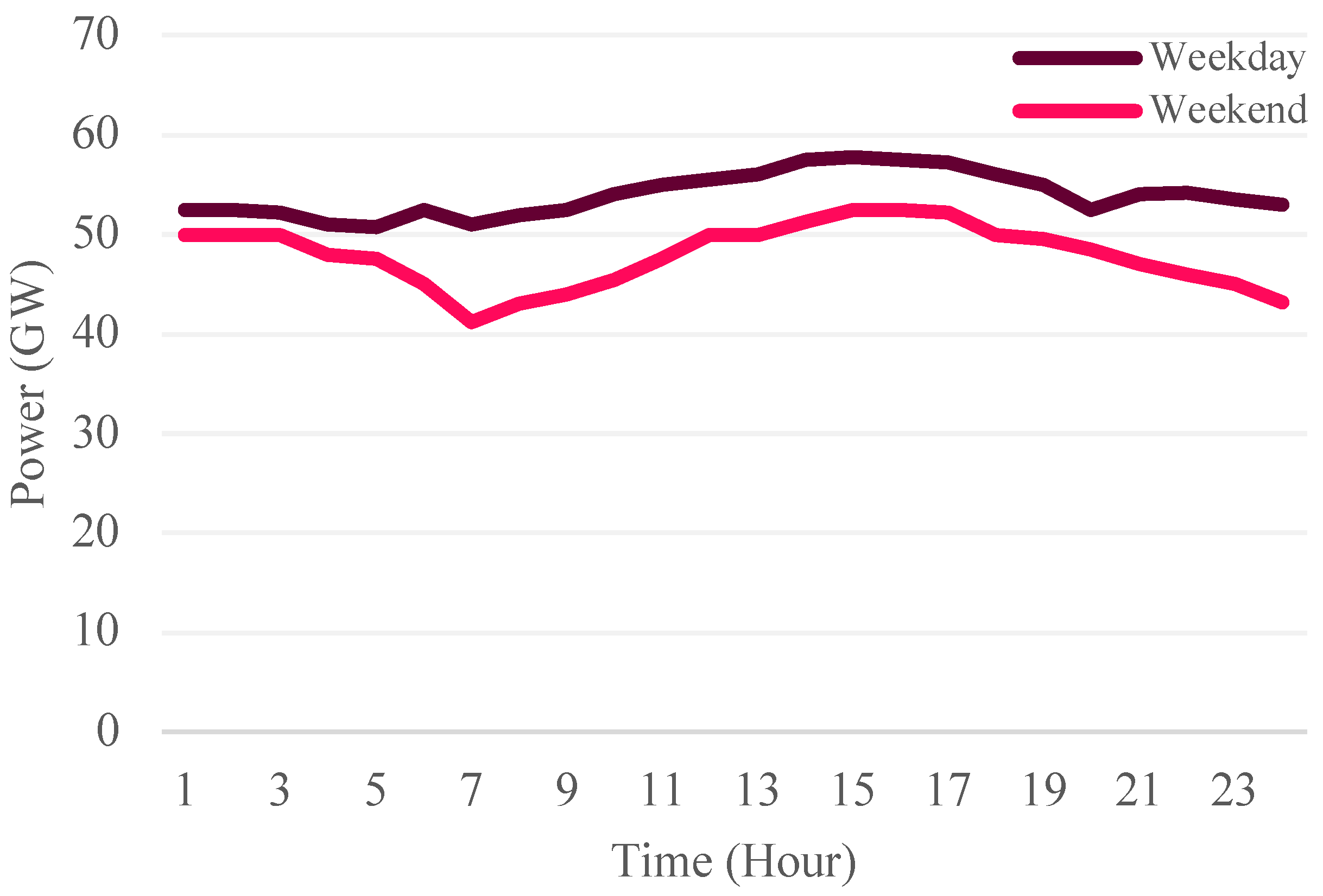





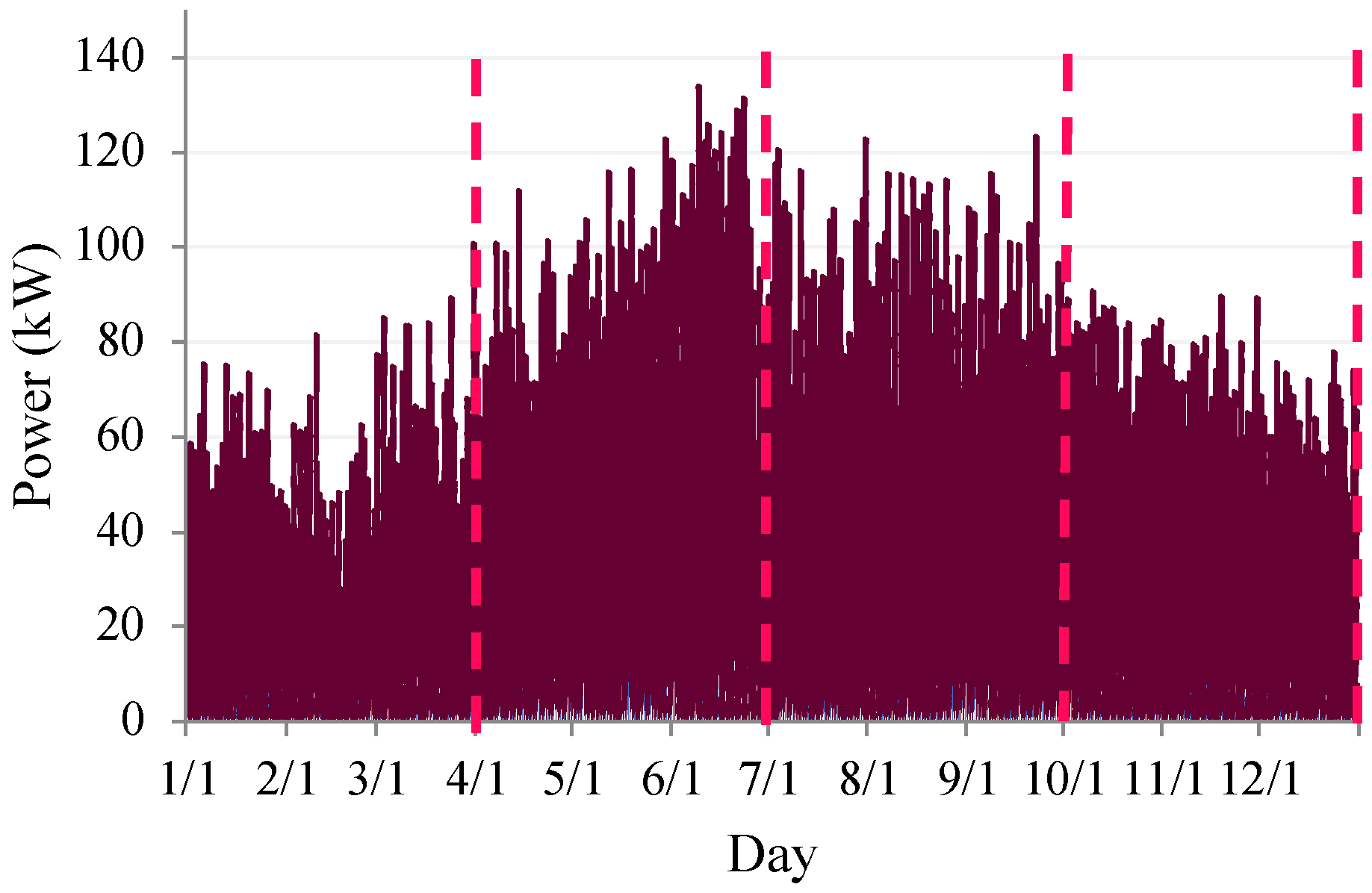
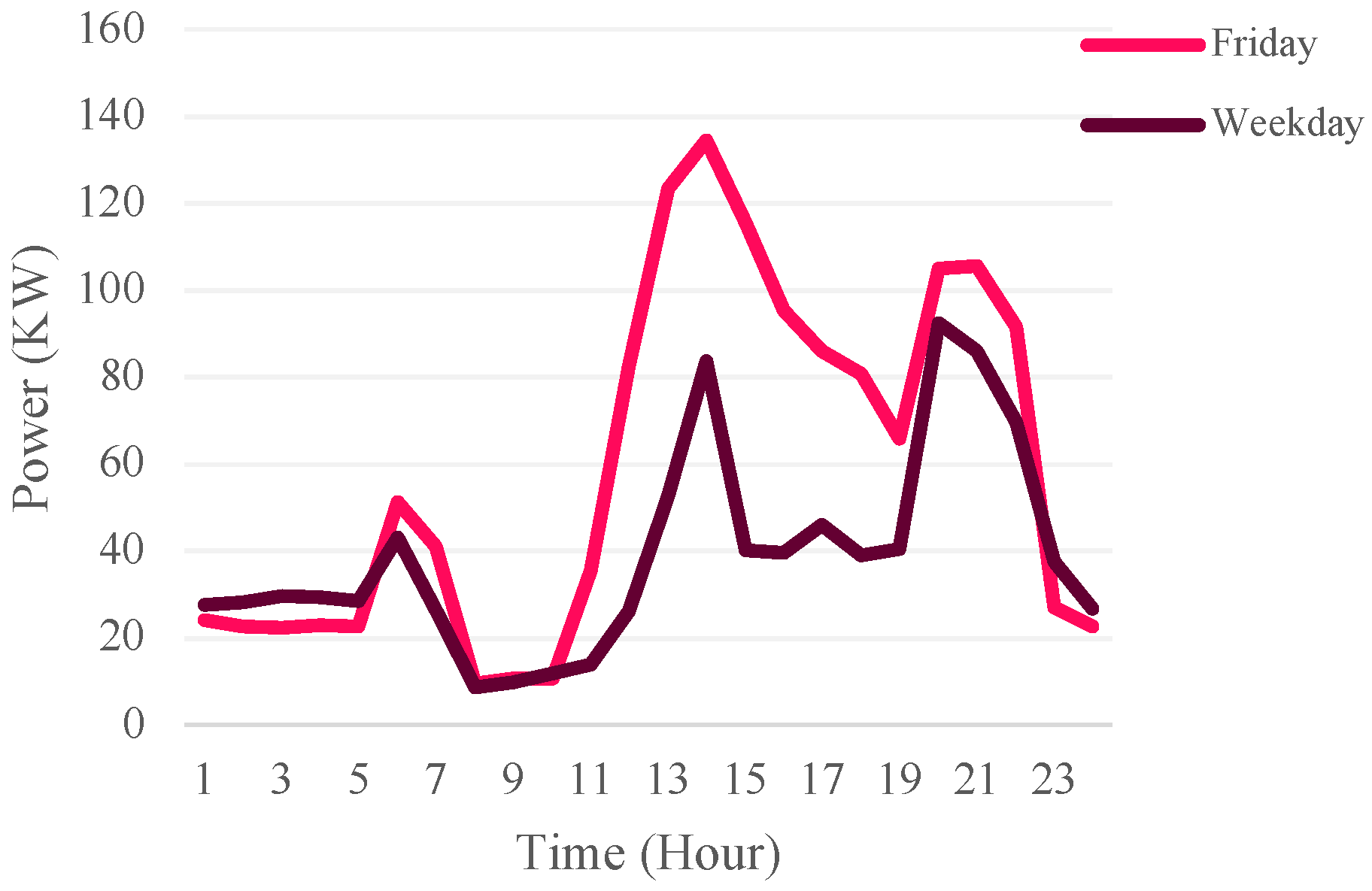
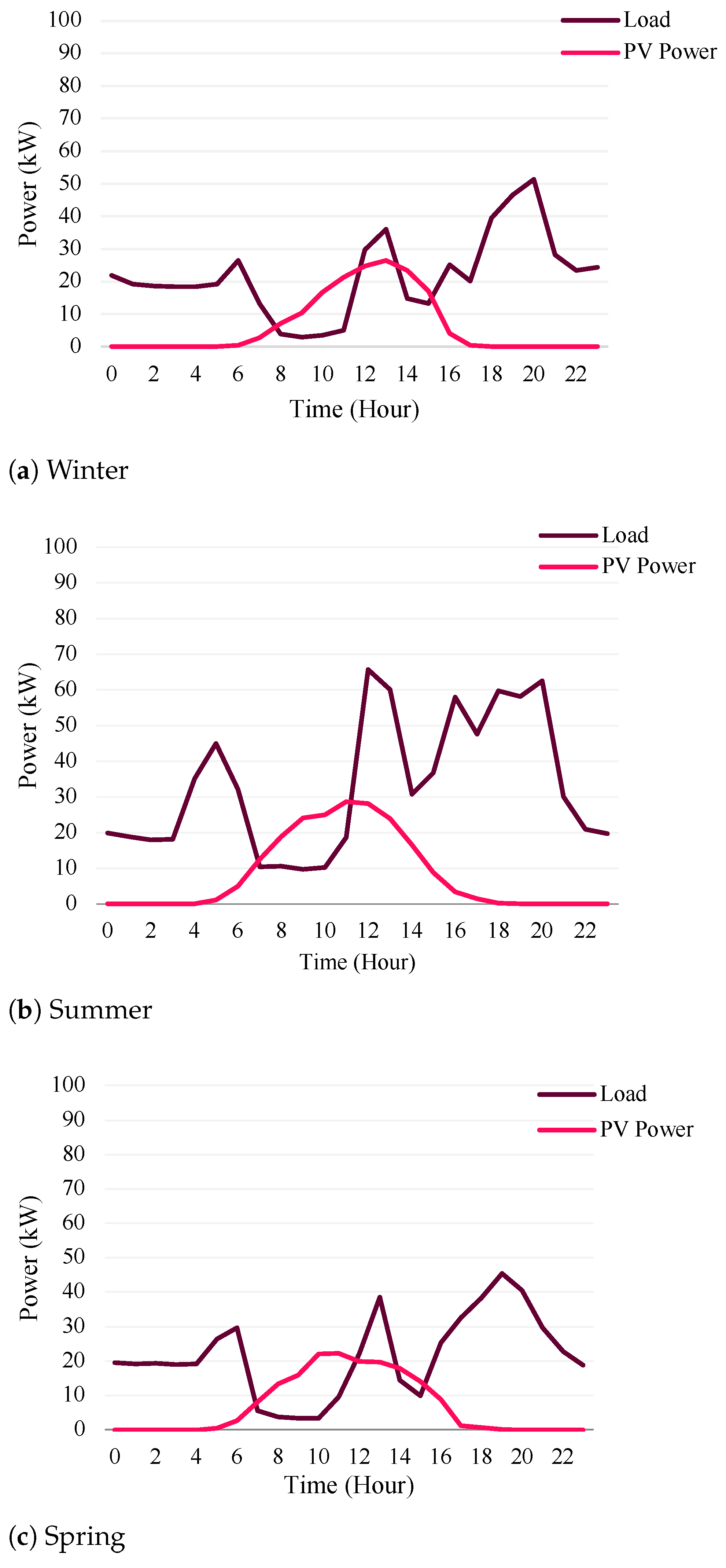

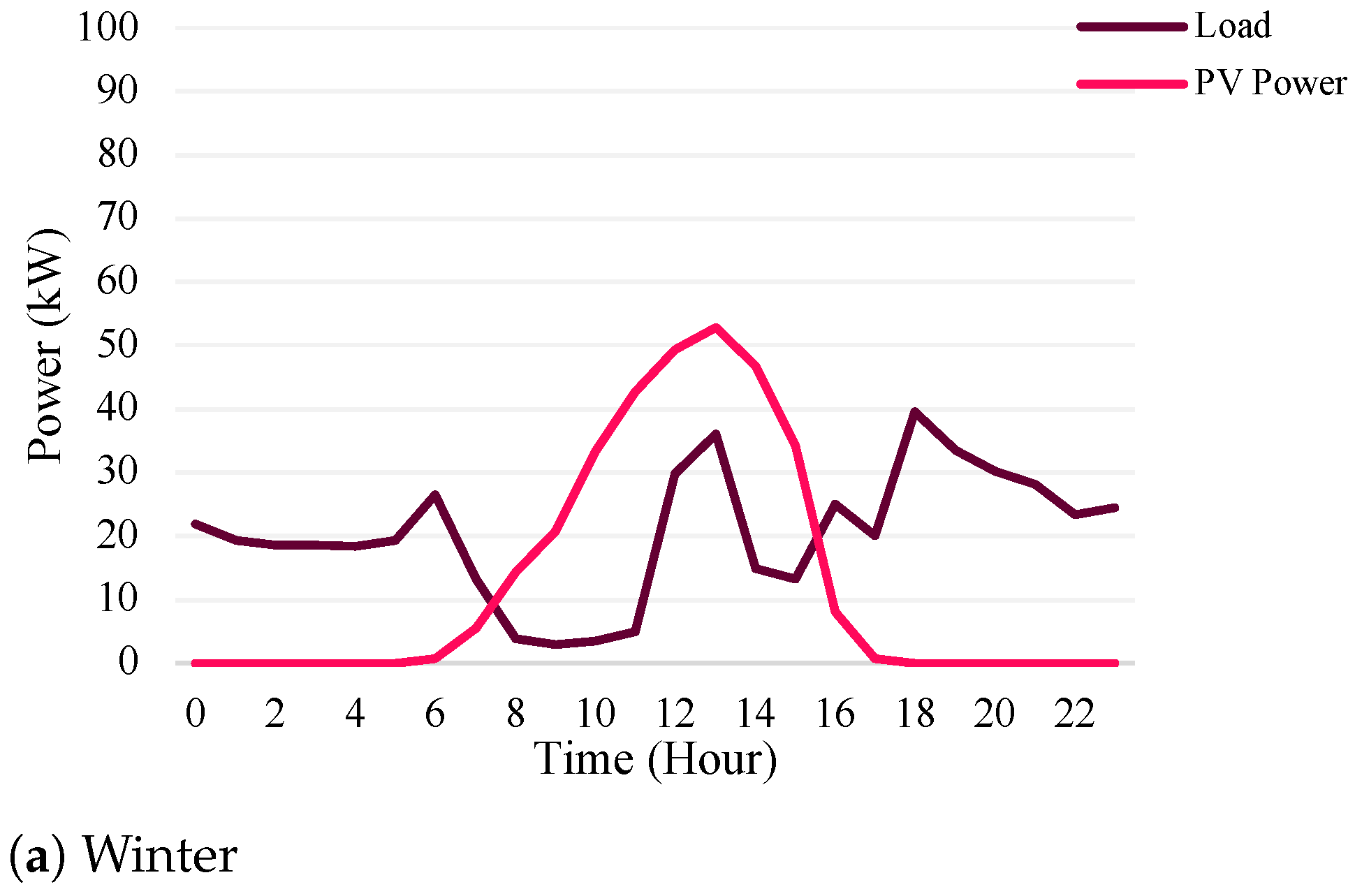


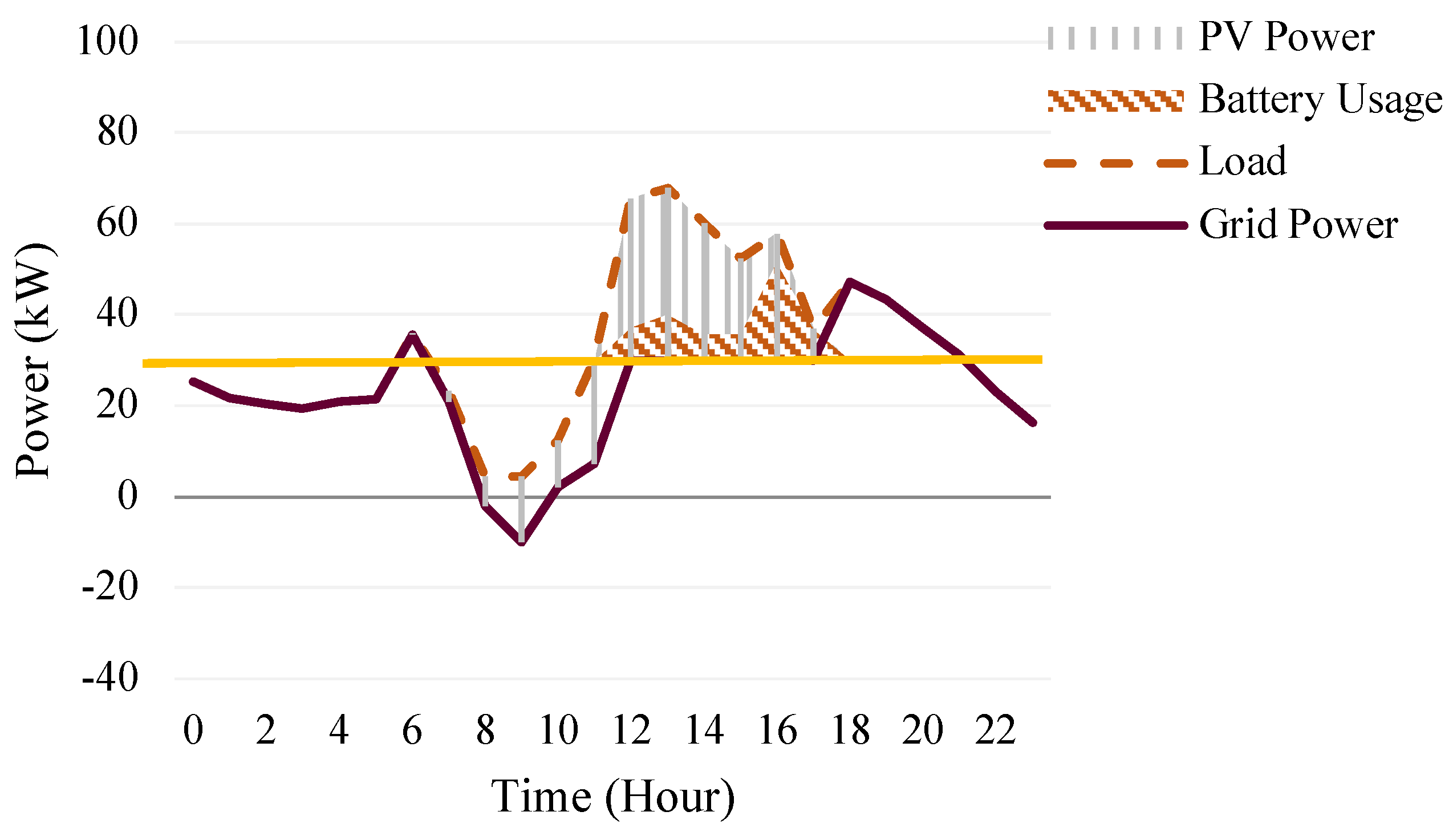

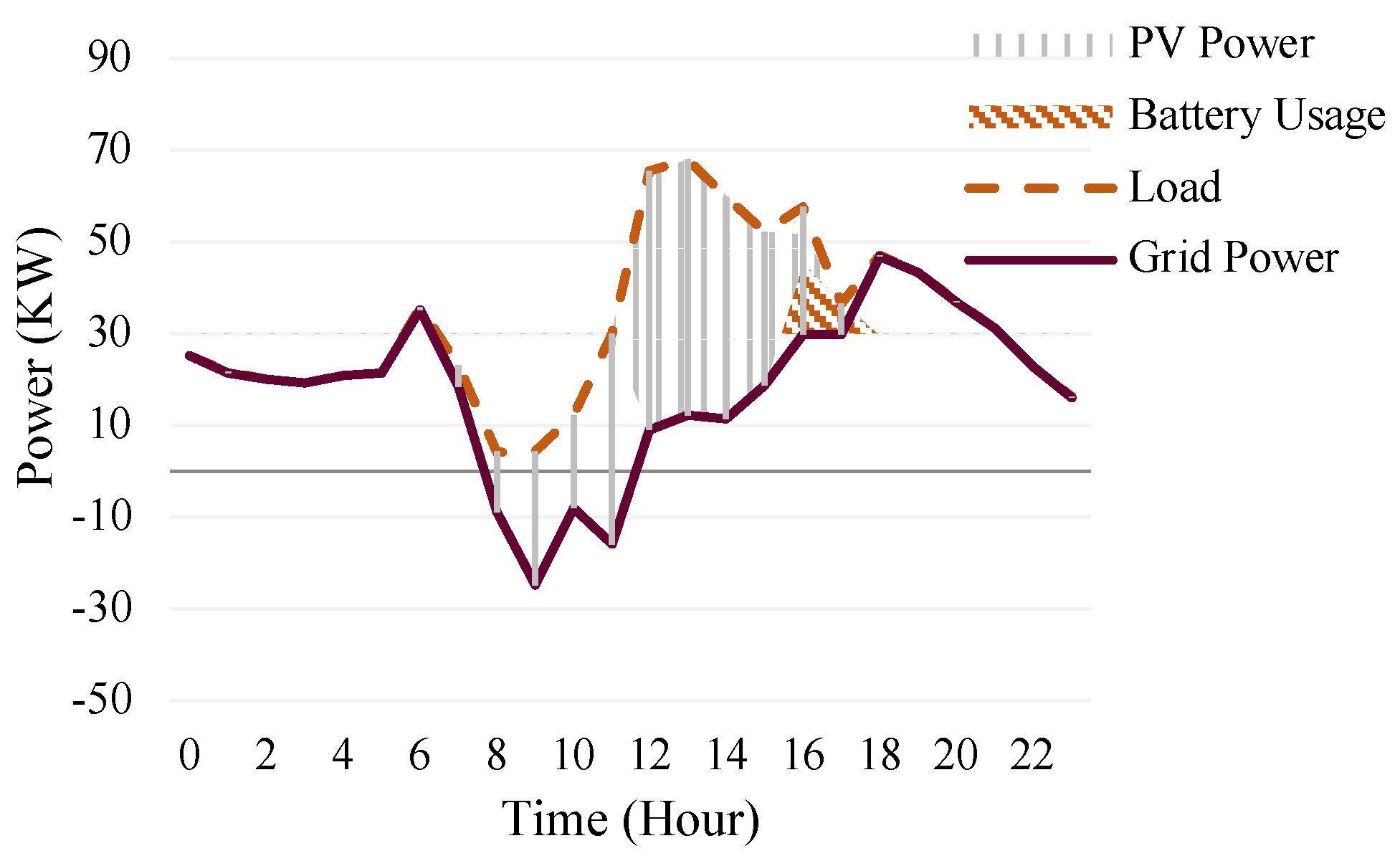
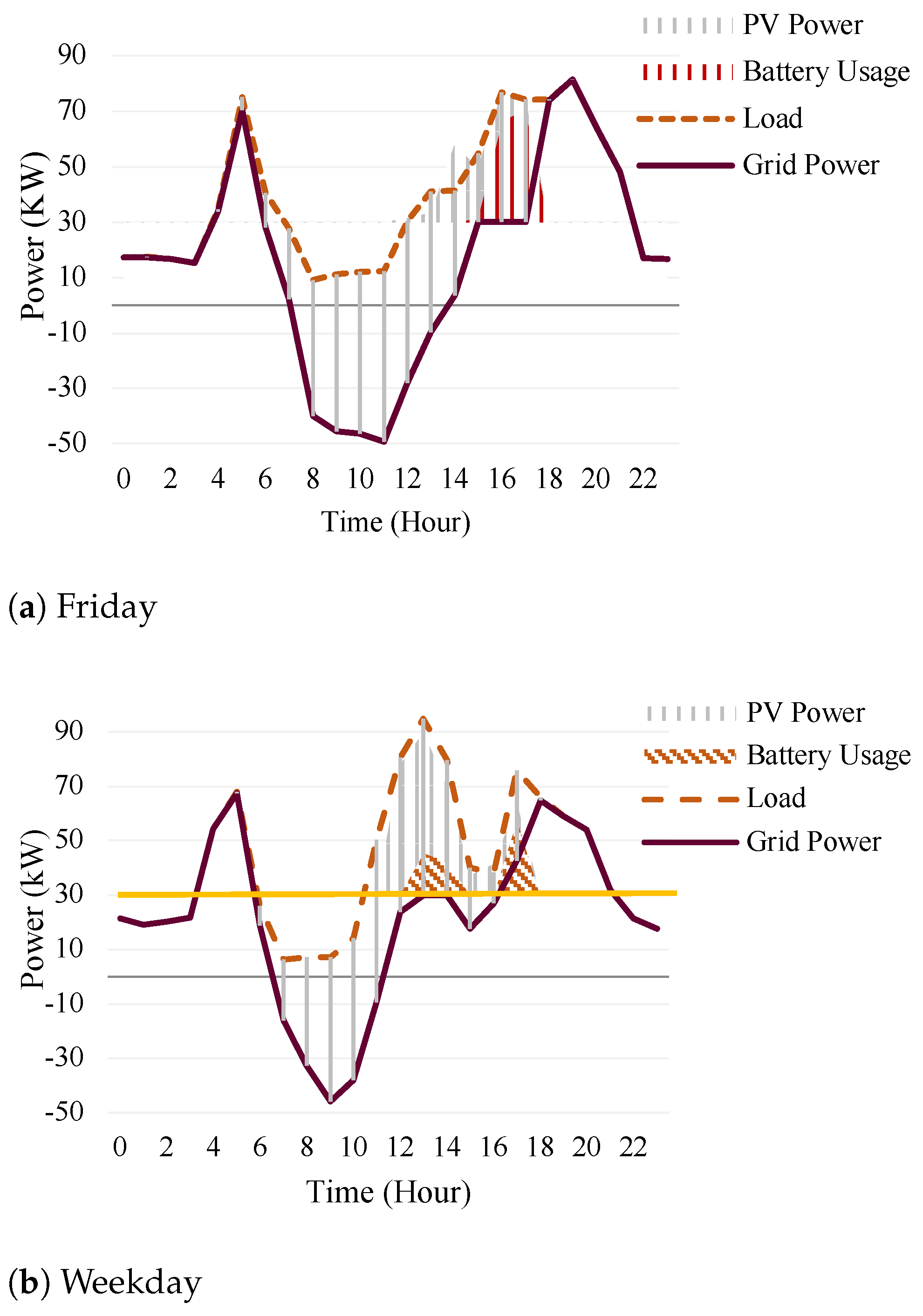


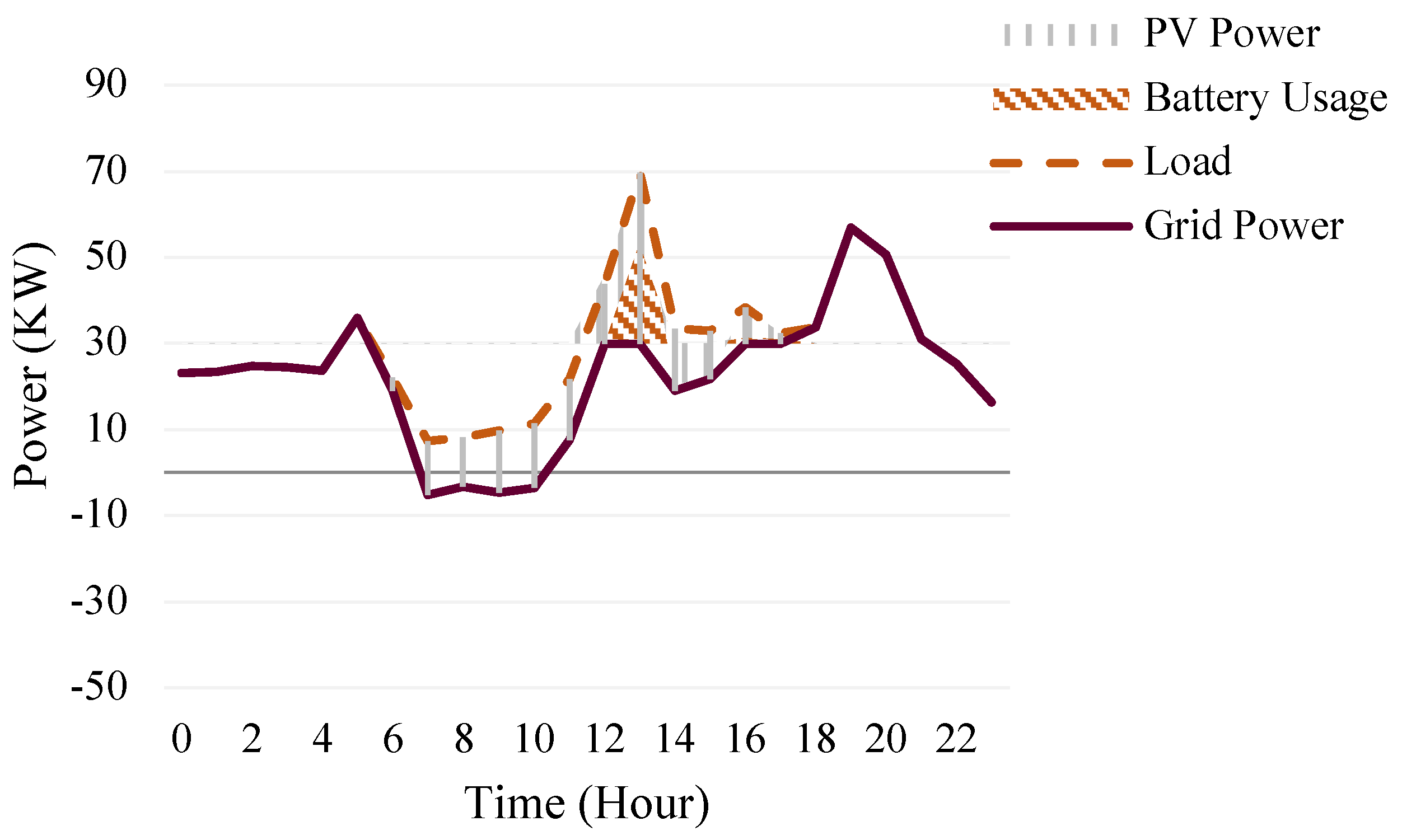

| Duration | Training Set | Test Set |
|---|---|---|
| Winter | January–March | 5 days |
| Spring | April–June | 5 days |
| Summer | July–September | 5 days |
| Autumn | October–December | 5 days |
| RMSE | MAE | nMAE | nRMSE | |
|---|---|---|---|---|
| Polynomial | 14.08 | 9.88 | 7.32 | 11.23 |
| DT | 10.59 | 7.36 | 5.49 | 8.37 |
| KNN | 11.34 | 7.83 | 5.84 | 9.08 |
| NN | 12.06 | 8.35 | 6.23 | 9.66 |
| SVR | 12.55 | 8.67 | 6.47 | 10.05 |
Disclaimer/Publisher’s Note: The statements, opinions and data contained in all publications are solely those of the individual author(s) and contributor(s) and not of MDPI and/or the editor(s). MDPI and/or the editor(s) disclaim responsibility for any injury to people or property resulting from any ideas, methods, instructions or products referred to in the content. |
© 2024 by the authors. Licensee MDPI, Basel, Switzerland. This article is an open access article distributed under the terms and conditions of the Creative Commons Attribution (CC BY) license (https://creativecommons.org/licenses/by/4.0/).
Share and Cite
Alhazmi, M.; Alfadda, A.; Alfakhri, A. Analysis of a Grid-Connected Solar PV System with Battery Energy Storage for Irregular Load Profile. Energies 2024, 17, 3463. https://doi.org/10.3390/en17143463
Alhazmi M, Alfadda A, Alfakhri A. Analysis of a Grid-Connected Solar PV System with Battery Energy Storage for Irregular Load Profile. Energies. 2024; 17(14):3463. https://doi.org/10.3390/en17143463
Chicago/Turabian StyleAlhazmi, Mohannad, Abdullah Alfadda, and Abdullah Alfakhri. 2024. "Analysis of a Grid-Connected Solar PV System with Battery Energy Storage for Irregular Load Profile" Energies 17, no. 14: 3463. https://doi.org/10.3390/en17143463
APA StyleAlhazmi, M., Alfadda, A., & Alfakhri, A. (2024). Analysis of a Grid-Connected Solar PV System with Battery Energy Storage for Irregular Load Profile. Energies, 17(14), 3463. https://doi.org/10.3390/en17143463






